If you're making a sci-fi film set in the 23rd century on a deep
space mining colony, you might think that heavy CG builds and a ton of
visual effects shots would be necessary. But that's where the new sci-fi
film, Infini, from director Shane Abbess, is different. While
there are some stunning set extensions, hologram work and plenty of
visual effects enhancements, the production skewed heavily on carefully
constructed sets, practical effects and practical solutions for visual
effects.
“I see the role as a visual effects supervisor as not just a digital consultant,” says Infini's visual effects supervisor (and fxphd Prof.) Steve Anderson. “It’s about finding the path to the best effect for the available time and budget. That path is not always best achieved via digital methods. It’s always good to look in the back catalog for how things are done.”
We find out from Anderson how just some of the 350-odd shots were achieved for Infini, a film on which fxphd alumni Mat Graham was a producer. The shots we cover include real-life ASCII art screens, ooze-filled blood and creature gags and some elaborate stunt and set extension work. Most were achieved via an in-house effects unit.
Oozing with time
In the film, the presence of an alien force causes some strange phenomena to occur - including the apparent backwards motion of dripping blood.
That blood effect might typically be achieved by reversing high speed film, but Anderson was aware the final result can appear problematic. “I’m always adverse to doing reverse gags,” he says. “It is a little obvious to our vision memory where you can pick up on little accents of motion blur and acceleration/deceleration when it’s the wrong way around.”
Although Anderson created a first test with a speaker, he eventually settled on using a stepper motor to drive the phase effect event. “It had more torque and fine control,” he notes. “We just attached that to the table and created that vibration in sympathy with the camera. We also had to have a very shutter angle otherwise it wouldn’t work. We did have to have a little bit more light than we would have needed if we went the high speed route, though.”
With that blood effect so successfully achieved practically, Infini’s special effects supervisor Phillip Young consulted Anderson on another effect - the creepy ‘jelly fingers’ - that he was looking to solve. “We used the same stepper motor drivers to add all the secondary and tertiary motion to the worm-like forms,” outlines Anderson. “We had little strings to lift the heads but all of that lovely sinusoidal motion was entirely in camera and from the same phase gauge to give it that slow jelly-like undulation.”
To solve the effect, the team elected to cover a stand-in actor, Goran D. Kleut, with KY Jelly lubricant. “He has this most unique form and is able to contort his body into the most extreme shapes and poses that really fit the bill to create something that was a little bit creepy and other worldly,” notes Anderson. “We shot his body for traditional crowd replication but of course the poor bugger was covered in KY jelly with a little bit of metal fleck added to it. He had to stand up there for a couple of hours freezing his nuts off!”
“Then Daniel as Whit stood in the same position and mimicked what Goran had done with his head movements,” adds Anderson. “We did enough takes that we had enough overlap and could marry heads to bodies.”
“It was an XML based bunch of ASCII that we could rig up that illustrated the drilling process,” explains Anderson. “And an entire map of the world. We were in geek heaven writing all of that! We put little Easter eggs in there - story points and mythos for all of the universe. Anyone who wants to go pausing and scanning those screens will be rewarded.”
For the stunt, MacPherson (or his stunt double) was filmed running through a corridor set backed with greenscreen and leaping onto a mat, with a camera operator following in a lightweight EPIC rig. The side view involved a wire rig and greenscreen setup. The fall saw the stunt double take a 12 meter tumble to a greenscreen crash mat below.
Visual effects artists then incorporated CG geometry as backgrounds, crafting two and a half-D matte paintings and ensuring depth cues were present in the shots. Similarly, scenes with outside views were aided by projecting matte paintings into the space.
“This meant that at least the light from outside an apartment would reflect in and interact with all of the reflective surfaces inside,” says Anderson, “and that would let the DOP and director frame up shots properly and not just be second-guessing visual effects.”
For Anderson, that approach - which also involved re-creating sets digitally with photogrammetry - was about keeping the visual effects manageable and in budget.
“We were not going to burn our budget for one given effect that may not be that necessary to tell the story,” he says. “It certainly was a challenging level of scope with the time and budget but we’re very proud of what we achieved.”
“I see the role as a visual effects supervisor as not just a digital consultant,” says Infini's visual effects supervisor (and fxphd Prof.) Steve Anderson. “It’s about finding the path to the best effect for the available time and budget. That path is not always best achieved via digital methods. It’s always good to look in the back catalog for how things are done.”
We find out from Anderson how just some of the 350-odd shots were achieved for Infini, a film on which fxphd alumni Mat Graham was a producer. The shots we cover include real-life ASCII art screens, ooze-filled blood and creature gags and some elaborate stunt and set extension work. Most were achieved via an in-house effects unit.
Oozing with time
In the film, the presence of an alien force causes some strange phenomena to occur - including the apparent backwards motion of dripping blood.
That blood effect might typically be achieved by reversing high speed film, but Anderson was aware the final result can appear problematic. “I’m always adverse to doing reverse gags,” he says. “It is a little obvious to our vision memory where you can pick up on little accents of motion blur and acceleration/deceleration when it’s the wrong way around.”
Infini was shot by DOP Carl
Robertson on the ARRI Alexa in full 4:3 with 2:1 anamorphic lenses. “We
had these vintage lenses from the 1980s,” says Anderson, “that when you
pull focus there was a whole lot of breathing going on, heaps of
chromatic aberration and some soft corners and vignetting - all the kit
bag of lens issues that we had to deal with in visual effects.”
When Anderson read the blood moment in the script - a drip of blood
falls from the table and suspends itself in mid-air and then slowly
reverses itself back up onto the table - he immediately thought of
utilizing the ‘frame rate phase’ effect. “We found this reference on
YouTube where some people were using a speaker driven by a signal
generator to make a sign wave that’s really exactly the same as the
frame rate of the camera,” explains Anderson, “where you vary that
frequency ever so slightly to be a little slower or faster than the
frame rate. You get this snapshot moment 25 frames a second of a
repeated event, and when it’s ever so slightly out of phase it looks
like it’s slowly going forwards or backwards - like high speed
photography.”Although Anderson created a first test with a speaker, he eventually settled on using a stepper motor to drive the phase effect event. “It had more torque and fine control,” he notes. “We just attached that to the table and created that vibration in sympathy with the camera. We also had to have a very shutter angle otherwise it wouldn’t work. We did have to have a little bit more light than we would have needed if we went the high speed route, though.”
With that blood effect so successfully achieved practically, Infini’s special effects supervisor Phillip Young consulted Anderson on another effect - the creepy ‘jelly fingers’ - that he was looking to solve. “We used the same stepper motor drivers to add all the secondary and tertiary motion to the worm-like forms,” outlines Anderson. “We had little strings to lift the heads but all of that lovely sinusoidal motion was entirely in camera and from the same phase gauge to give it that slow jelly-like undulation.”
Oozing with aliens
Towards the end of the film, the image of crew member Whit Carmichael (Daniel MacPherson) is revealed amongst a number of aliens - the ‘jelly people’ - in semi-transparent form. Again, the visual effects for these shots were not completed in the usual way. “The brief was that the slime and ooze was forming and learning to take the shape of human,” says Anderson. “We had to give the impression of Whit's face being formed on these rather exaggerated or skeletal jelly forms. In a perfect world, we would have gone a full CG route. But in the constraints of what we had to play with, we had to think our way around the problem.”To solve the effect, the team elected to cover a stand-in actor, Goran D. Kleut, with KY Jelly lubricant. “He has this most unique form and is able to contort his body into the most extreme shapes and poses that really fit the bill to create something that was a little bit creepy and other worldly,” notes Anderson. “We shot his body for traditional crowd replication but of course the poor bugger was covered in KY jelly with a little bit of metal fleck added to it. He had to stand up there for a couple of hours freezing his nuts off!”
“Then Daniel as Whit stood in the same position and mimicked what Goran had done with his head movements,” adds Anderson. “We did enough takes that we had enough overlap and could marry heads to bodies.”
ASCII art
The control room on the deep space mining station features views to the extreme outdoors, as well as several monitors with information and read-outs. These days it would not be uncommon for the graphics to be burned in during post, but for these particular shots a unique approach was undertaken. Production networked more than 20 Raspberry Pi computers and monitors which were coded with interactive ASCII-like code - programs that the actors could actually interact with by typing and pressing buttons.“It was an XML based bunch of ASCII that we could rig up that illustrated the drilling process,” explains Anderson. “And an entire map of the world. We were in geek heaven writing all of that! We put little Easter eggs in there - story points and mythos for all of the universe. Anyone who wants to go pausing and scanning those screens will be rewarded.”
Making the stunt
The film also involved much more traditional visual effects - from CG sets, matte paintings, environments to composites. One of the more challenging shots involved Carmichael making a run for it from members of his newly-infected team and leaping over a chasm, only to fall 30 meters.For the stunt, MacPherson (or his stunt double) was filmed running through a corridor set backed with greenscreen and leaping onto a mat, with a camera operator following in a lightweight EPIC rig. The side view involved a wire rig and greenscreen setup. The fall saw the stunt double take a 12 meter tumble to a greenscreen crash mat below.
Visual effects artists then incorporated CG geometry as backgrounds, crafting two and a half-D matte paintings and ensuring depth cues were present in the shots. Similarly, scenes with outside views were aided by projecting matte paintings into the space.
“This meant that at least the light from outside an apartment would reflect in and interact with all of the reflective surfaces inside,” says Anderson, “and that would let the DOP and director frame up shots properly and not just be second-guessing visual effects.”
For Anderson, that approach - which also involved re-creating sets digitally with photogrammetry - was about keeping the visual effects manageable and in budget.
“We were not going to burn our budget for one given effect that may not be that necessary to tell the story,” he says. “It certainly was a challenging level of scope with the time and budget but we’re very proud of what we achieved.”

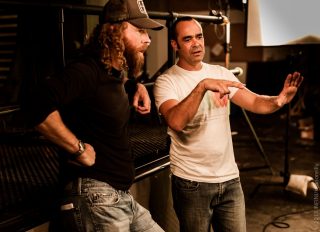





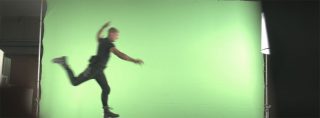
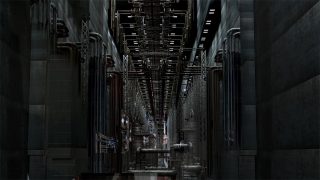
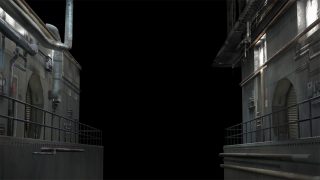
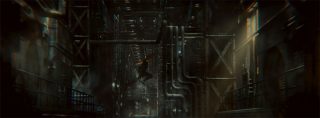
No comments:
Post a Comment